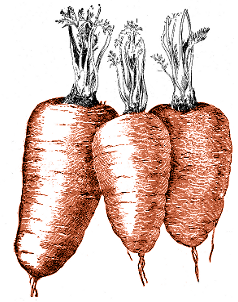Page 5 of 7
Posted in Garden Diary, Photobloggery, The Old Garden In Bristol on Saturday, February 25th 2012 (7.46 PM).
As you might have noticed from the date of the last post, not much gardening has been done recently. Even though I went out to swap seeds, nothing yet has been sown. It has still felt cold and frosty, damp and grey, at least until a warm bright morning this morning. I went outside and noticed that the chives have started to wake up. Grown from seed last year, they did not come to much in their first year. However, they seem to be coming back again, because each plant now has a cluster of new shoots poking upward.
Moreover, the three boxes of rocket, which I had been intending to pull up, are bursting back into life too. The wild rocket had been laying low but hanging on, a carpet of foliage which managed to survive the frost and snow we had earlier in the month. This morning, I noticed that in the past week it has bolted and burst into flower.
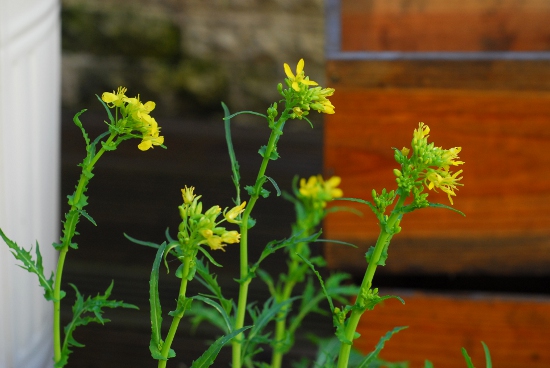
The two boxes of garden rocket had even managed to keep their flowers all winter. These too, though, have started growing fresh flower shoots and buds recently.
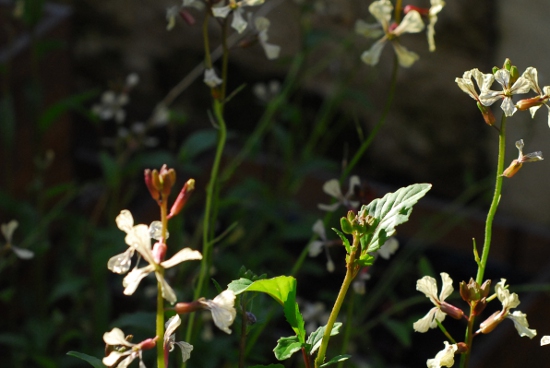
Pulling them up is on hold for now: at this time of year, anything in flower deserves to be kept for the sake of the local insect wildlife. I do love letting the garden rocket go to seed: last summer each rocket flower stem was surrounded by a cloud of hoverflies for most of the day. The neighbourhood hoverflies are still waiting to emerge, but no doubt there are other hungry insects looking for nectar right now.
chives, flowering, garden rocket, rocket, spring, wild rocket
Posted in Practicalities on Sunday, February 5th 2012 (6.03 PM).
This afternoon: a seed swapping event at my favourite cinema, The Cube off King Square. I felt rather sheepish going along, because I felt I didn’t have any seeds to take. I do have seeds I’ve saved, but I have no idea at all if any of them are viable, so didn’t feel I could pass them on to the rest of the Bristol gardening community quite yet.
However, it wasn’t a wasted trip, because there was plenty to do besides swap seeds. There was a Compost Cam showing people just how entrancing worms can be to watch; there were taste tests inviting you to spot the home-grown food; and, being a cinema, there were documentary showings. I was particularly interested by one, a BBC documentary from two or three years ago, on the future of farming. In a nutshell: modern farming is doomed. Modern farming needs oil, lots of it, both for combustion engines and for chemical feedstock. As the oil industry declines, modern farming – and the entire modern food economy – will rapidly become unaffordable. All very depressing. The answer, according to the programme, is in seeing biodiversity as an essential part of food production rather than just something that gives us pretty wildlife; in designing agricultural systems which work with rather than against our natural environment; and in a move away from factory-scale agriculture towards smallholdings, because organic smallholdings, run by gardeners rather than farmers, can produce rather more food per acre than an industrial farm can. One thinks here of the Soviet Union, where despite the vast acreage of mechanised kolkhoz and sovkhoz farms, all of the quality food, and a big proportion of the staples, was cultivated on the smallholdings of kolkhoz employees in their spare time and sold in barely-tolerated private markets. Gardeners are better than farmers, it seems. Unfortunately, this is because gardeners devote much more time and attention to each square metre of land than a farmer can, and any sort of smallholding-based solution to the oncoming food supply problem will mean social change at an earth-shattering level.
The other question which comes up regularly in my mind, which the documentary reminded me of, is: just how sustainable, in the long term, is the sort of small-back-garden container gardening that I do? Because, on the face of it, it doesn’t seem to be the healthiest form of gardening. Sustainability is all about generating healthy, fertile soil, soil with its own ecosystem. The ecosystem is needed to replace everything that my plants take away, to replace everything that ends up in my dinner, and if nothing ever goes back into the soil to replace that the soil ends up dead. The general “conventional” guideline for container gardening seems to be: “use fresh compost; grow your plants; your compost is now exhausted”. That process isn’t going to build up any sort of long term sustainability.
I do have some thoughts and ideas about the above: how to make container gardening more sustainable, at the systemic level. The container garden equivalent of the medieval three-field system, maybe. This post is already well into TLDR territory, so those thoughts will come later. In other news, I just hope that the Cube do hold another event next year, when I can donate more to the proceedings myself.
bristol, farming, saving seed, seed, seed swap, sustainability
Posted in Inspiration on Saturday, January 28th 2012 (5.41 PM).
The last inspiration post was a cemetery in distant Berlin. Today’s inspiration is also a cemetery, but one a bit closer to home. Arno’s Vale, in Totterdown, Bristol.
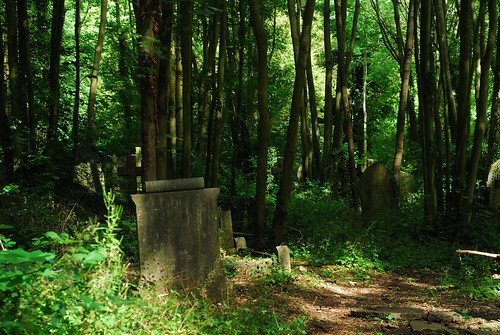
Arno’s Vale today is a beautiful wooded spot: but it was never intended to look quite like this. It was designed as a garden cemetery, a carefully-manicured hillside opened in 1839, the same year as Highgate Cemetery and a few years after the pioneering Kensal Green Cemetery. Like Kensal Green, it was run as a commercial business; and it was very successful for many years.
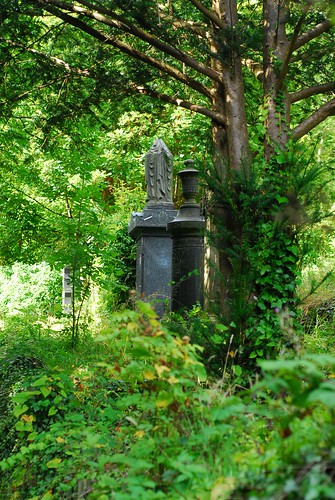
Unlike Kensal Green, Arno’s Vale started to run out of space in the 20th century; and as new burials fell, the viability of the cemetery as a business also started to fade. The cemetery management had to cut back on maintenance staff; and as they did so, trees and undergrowth started to take over. By the time the business finally went under, the cemetery was completely overgrown.
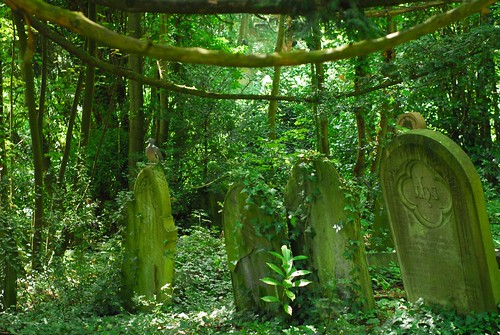
In more recent years the cemetery was saved from both too much decay, and the threat of redevelopment, by a group of campaigners. It now is owned by the city council, but managed and maintained by a charitable trust with the help of many volunteers.
arnos vale, brislington, bristol, cemetery, forest, overgrown, public garden, totterdown, undergrowth
Posted in Decorative, Practicalities on Thursday, January 19th 2012 (6.08 PM).
As I mentioned our seed tin in passing the other day, I thought I might tell you a bit more about it. I asked for it on my Christmas list last year, and it comes from Ripe, a little independent homeware supplier that used to have a shop on Perry Road, but now operate from a mail-order address in Totterdown. It is, technically, a lunch tin, with cartoon hedgehogs on the side.
The Mother phoned up, after getting the list. “This tin. You do realise it’s a child’s lunch tin?” Well, yes. “You could use any old tin to keep seeds in!” I’m not sure she really understood that just having a tin wasn’t entirely the point.
seed, storage
Posted in Experimentation, Garden Diary, Photobloggery, Planning, The Old Garden In Bristol on Sunday, January 15th 2012 (11.21 AM).
Given the crisp winter weather yesterday, we went out for a walk: down to Spike Island, along the New Cut, then back round in a circle through the back streets of Southville. I noticed, all of the rosemary bushes in the front gardens of Southville are in flower at the moment. Even in January.
The rosemary bush in our garden on the other side of the city is not in flower. I say “bush”: possibly “sprig” is a slightly better word. There are signs, though, that it might be starting to bud, pale green growing tips at the base of each leaf. Something is developing, at least; I don’t know much about rosemary yet.
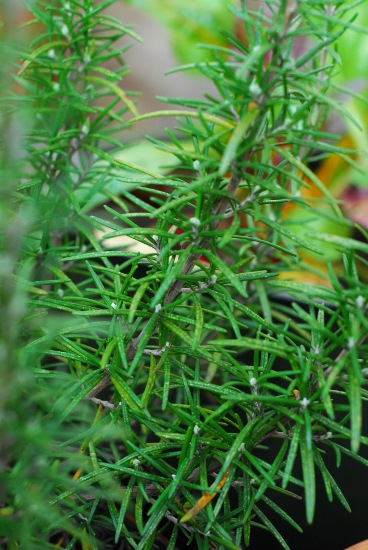
In other news, we’ve been trying to do a bit more planning on what to grow this year. We had a good harvest last year from the peas we planted, but before the season was over the plants were suffering rather badly from mildew, possibly because we planted slightly too many in each box – after all, when you only have so much space it is tempting.
I have no idea what pea variety we grew last year. Towards the end of the planting season, we popped down to the garden centre, bought whatever type of pea seedlings they had available, and that was that. “Pea” was all it said on the label. For this season, therefore, we have deliberately gone out and bought seed of a disease-resistant variety: P. sativum “Boogie”. Whether they are as tasty or fruitful as last year’s anonymous ones, we will have to wait and see, but the packet of seed peas is ready and waiting in the seed tin.
boogie, bristol, disease, flowering, mildew, pea, rosemary, southville, unseasonal, winter
Posted in Garden Diary, Photobloggery, The Old Garden In Bristol on Tuesday, January 10th 2012 (6.23 PM).
Not very much happened the first week in January. Too cold, too damp, still too dark in the morning and evening. But the garlic has kept on coming: now with shoots up everywhere, even the cloves planted three weeks after the others. This one was, when I took the photo on Sunday, one of the furthest on:
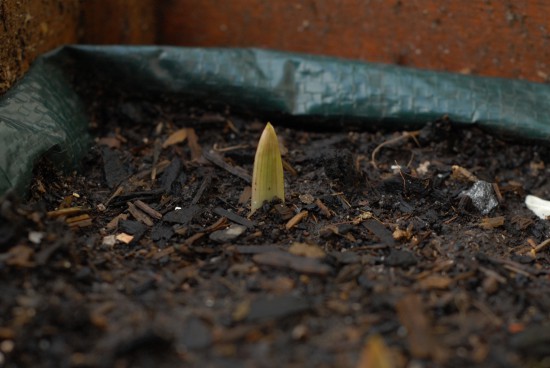
They remind me of Jason And The Argonauts: the spears of King Aeëtes’ army as his soldiers start to grow out of the earth.
garlic, germination, sprouting, winter
Posted in Garden Diary, Photobloggery, Practicalities, The Old Garden In Bristol on Monday, January 2nd 2012 (11.09 PM).
The intention, over the long Yuletide break, was to finish off tidying up the garden, clean out those remaining pots which had last year’s perennials in, and get straight on with finishing the digging of the back bed. The reality, however, was that the sofa and fireside proved too attractive.
Despite that, I have started to use one of the garden-related presents I received. From K’s sister: a garden-themed notebook.
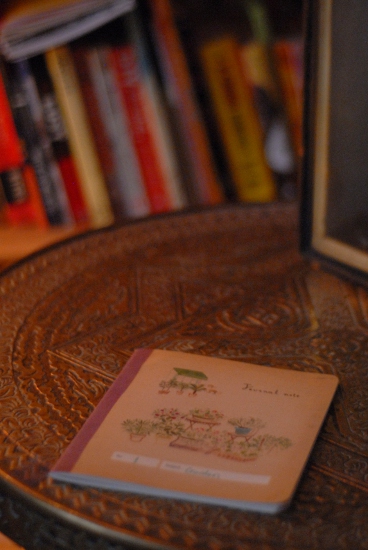
It came from Papermash, ultimately from a Korean stationery company, and inside is a normal ruled notebook; but I do love the watercolour cover. I’m going to use it as a garden diary notebook, so that I can write down what I’ve noticed when I notice it, and what I’ve done when I’ve done it, without having to come online and come here to make a note. So far it has but one entry, from last Wednesday, when I noticed the first garlic plant poking its shoot up above the surface of the soil. So far there is still only one shoot visible: I must have planted that clove rather shallower than the rest.
diary, garlic, notebook, record, recording, winter, yuletide
Posted in Garden Diary, Photobloggery on Sunday, December 25th 2011 (7.13 AM).
This isn’t our garden. But it is a Christmas garden. K’s parents’ house, three years ago today, in deep snow.
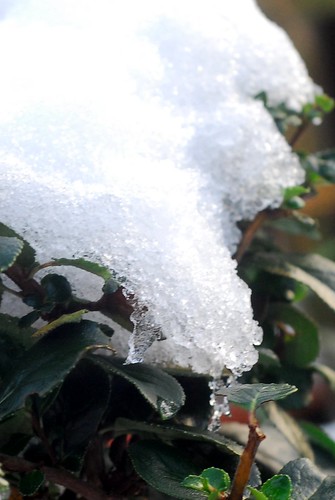
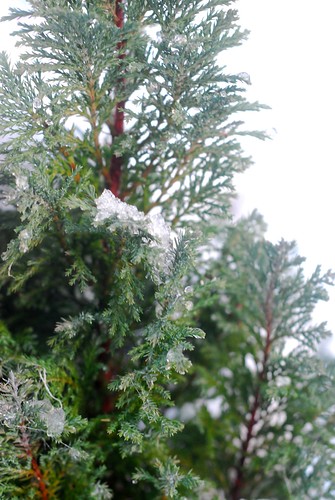
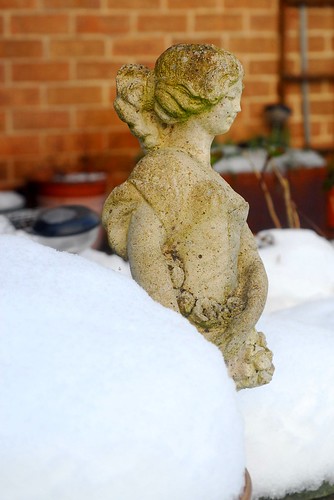
Merry Christmas, and a happy garden Yuletide!
snow, weather, winter, yuletide
Posted in Garden Diary, The Old Garden In Bristol on Sunday, December 18th 2011 (8.28 PM).
The frost has really started to come in in the past week. I’m learning which parts of the garden are hit by it the hardest: the sheltered area between shed and house stays frost-free the longest, and the other side of the shed, where the bee house is, also seems to stay fairly sheltered. The middle of the garden, and the prime planting area, get hit the hardest, although so far this winter the perennial plants seem to be largely bearing up. Fingers crossed.
After I planted the garlic, three weeks ago, there were a few small cloves left over from the bulb. Today, I planted those up in the containers that, this year, we grew carrots in. The carrots – more of that free BBC seed – did not really grow very well, possibly because the containers are a little small. We will see how the garlic does: we’re starting, in these containers, with the least-viable-looking cloves already, so there won’t really be any scientific conclusions we can draw from it.
The three-weeks-planted garlic hasn’t appeared above the surface yet. K says I’m being silly, looking regularly, because at this time of year it won’t break the surface for months. But, still, I keep looking to see if sprouts have appeared.
carrot, frost, garlic, planting, weather, winter
Posted in Photobloggery, Practicalities, The Old Garden In Bristol on Sunday, December 11th 2011 (3.10 PM).
We missed harvesting the last green beans and runner beans this year, because we had a holiday planned. By the time we got home, they had gone past eating. Still, no point letting them go to waste, so we left the beans on the plant to develop and dry. That was the intention, at least: as the weather became wetter, it didn’t look like there was much chance of them drying successfully on the plant, so we picked them and popped them into a tub in the fridge – unsealed, but covered with kitchen roll. I gathered it would be a good drying-out spot for beans: cold, dark, and naturally drying. Now, a few weeks later, they are dry, hard, and ready to be popped into a storage tin. And they are beautiful: creamy-white green beans and rich, midnight blue and pink runner beans.
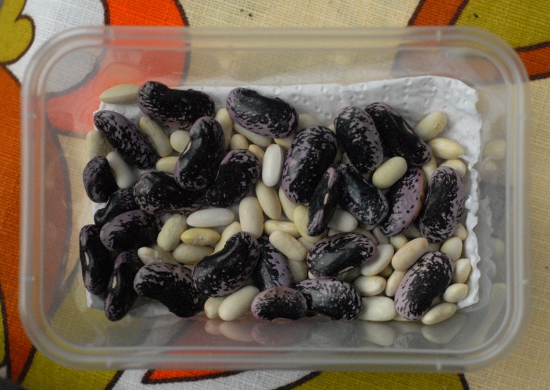
It is, really, the whole point of sustainable gardening. We are never going to be self-sufficient, with our little city plot, but equally we don’t want to be restocking our containers with freshly-grown garden centre seedlings each spring when we can raise our own instead. I don’t expect all of these seeds to be viable, but we don’t need many to be viable: this pot could fill our entire garden with beans if we wanted. This isn’t sophisticated breeding: the runner beans are from some spare plants a friend gave us, and the green beans are from some free seeds the BBC was giving out the other year, part of their Dig In project. Being beans, they might not even breed true, but hopefully next year’s bean supply is now in place.
bean, green bean, runner bean, saving seed, seed



